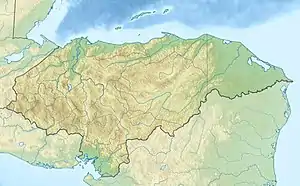Gracias Formation
The Gracias Formation is a geologic formation in Honduras. The mainly sandstones, siltstones and claystones preserve vertebrate fossils dating back to the Neogene period.[1]
| Gracias Formation Stratigraphic range: Miocene | |
|---|---|
| Type | Formation |
| Underlies | Pleistocene basalt |
| Overlies | Padre Miguel Group |
| Thickness | 200–300 m (660–980 ft) |
| Lithology | |
| Primary | Sandstone, siltstone, claystone |
| Other | Conglomerate |
| Location | |
| Coordinates | 21.2°N 100.7°W |
| Approximate paleocoordinates | 21.7°N 98.0°W |
| Region | Lempira Department |
| Country | |
| Type section | |
| Named for | Gracias |
| Named by | Williams & McBirney |
| Year defined | 1969 |
 Gracias Formation (Honduras) | |
Description
The Gracias Formation is a sedimentary unit, consisting of sandstone, siltstone, claystone and a few conglomeratic beds. The formation crops out in western Honduras and ranges from 200 to 300 metres (660 to 980 ft) in thickness. The formation overlies the Padre Miguel Group, while it is overlain by Pleistocene basalts.[2] The Padre Miguel Group provided the provenance for the sedimentary material for the Gracias Formation. The clasts in the formation are largely composed of rhyolite, rhyodacite, pumice, vitric ash, quartz, feldspar, and minor biotite fragments.[3]
Fossil content
- Borophagus secundus
- Calippus hondurensis[4]
- Cormohipparion ingenuum
- Procamelus cf. grandis
- Prosthennops cf. serus
- Protolabis cf. heterodontus
- Pseudoceras skinneri
- Rhynchotherium cf. blicki
- Teleoceras sp.
- Rhinocerotidae indet.
References
- Gracias Formation at Fossilworks.org
- N.N., s.a., Informe de Apoyo, A-9
- Sánchez Barreda, 1999, p.25
- Hulbert, 1988, p.272
Bibliography
- Hulbert, Jr., R.C. 1988. Calippus and Protohippus (Mammalia, Perissodactyla, Equidae) from the Miocene (Barstovian-early Hemphillian) of the Gulf Coastal Plain. Bulletin of the Florida State Museum, Biological Sciences 32. 221–340. Accessed 2019-02-09.
- Sánchez Barreda, Luis A. 1999. Geology of Mosquitía and Tela Basins, Honduras, 1–55. University of Texas at Austin. Accessed 2019-02-09.
- N., N. s.a. Informe de Apoyo - Estudio Geológico para la ciudad Tegucigalpa, A1-57. _. Accessed 2019-02-09.
Further reading
- E. C. Olson and P. O. McGrew. 1941. Mammalian fauna from the Pliocene of Honduras. Bulletin of the Geological Society of America 52:1219-1244
- S. D. Webb and S. C. Perrigo. 1984. Late Cenozoic Vertebrates from Honduras and El Salvador. Journal of Vertebrate Paleontology 4(2):237-254
This article is issued from Wikipedia. The text is licensed under Creative Commons - Attribution - Sharealike. Additional terms may apply for the media files.